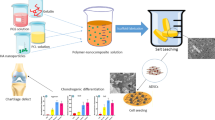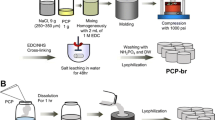Abstract
The current work is an attempt to study the strategies for cartilage tissue regeneration using porous scaffold in wavy walled airlift bioreactor (ALBR). Novel chitosan, poly (l-lactide) and hyaluronic acid based composite scaffold were prepared. The scaffolds were cross-linked with 1-ethyl-3-(3-dimethylaminopropyl) carbodiimide, N-hydroxysuccinimide and chondroitin sulfate to obtain interconnected 3D microstructure showing excellent biocompatibility, higher cellular differentiation and increased stability. The surface morphology and porosity of the scaffolds were analyzed using scanning electron microscopy (SEM) and mercury intrusion porosimeter and optimized for chondrocyte regeneration. The study shows that the scaffolds were highly porous with pore size ranging from 48 to 180 µm and the porosities in the range 80–92%. Swelling and in vitro degradation studies were performed for the composite scaffolds; by increasing the chitosan: HA ratio in the composite scaffolds, the swelling property increases and stabilizes after 24 h. There was controlled degradation of composite scaffolds for 4 weeks. The uniform chondrocyte distribution in the scaffold using various growth modes in the shake flask and ALBR was studied by glycosaminoglycans (GAG) quantification, MTT assay and mixing time evaluation. The cell culture studies demonstrated that efficient designing of ALBR increases the cartilage regeneration as compared to using a shake flask. The free chondrocyte microscopy and cell attachment were performed by inverted microscope and SEM, and from the study it was confirmed that the cells uniformly attached to the scaffold. This study focuses on optimizing strategies for the culture of chondrocyte using suitable scaffold for improved cartilage tissue regeneration.




Similar content being viewed by others

References
Griffith LG, Naughton G (2002) Tissue engineering—current challenges and expanding opportunities. Science 295:1009–1014
Guilak F, Butler DL, Goldstein SA (2001) Functional tissue engineering: the role of biomechanics in articular cartilage repair. Clin Orthop Relat Res 391:S295–S305
Kaur T, Thirugnanam A (2016) Tailoring in vitro biological and mechanical properties of polyvinyl alcohol reinforced with threshold carbon nanotube concentration for improved cellular response. RSC Advances 6:39982–39992
Maiti P, Patel D, Singh RK, Singh S, Aswal VK, Rana D, Ray B (2016) Graphene as chain extender of polyurethanes for biomedical applications. RSC Adv 6:58628–58640
Naseri N, Poirier J-M, Girandon L, Fröhlich M, Oksman K, Mathew AP (2016) 3-Dimensional porous nanocomposite scaffolds based on cellulose nanofibers for cartilage tissue engineering: tailoring of porosity and mechanical performance. RSC Adv 6:5999–6007
Pathria MN, Chung CB, Resnick DL (2016) Acute and stress-related injuries of bone and cartilage: pertinent anatomy, basic biomechanics, and imaging perspective. Radiology 280:21–38
Sharma C, Gautam S, Dinda AK, Mishra NC (2011) Cartilage tissue engineering: current scenario and challenges. Adv Mater Lett 2:90–99
Tibbitt MW, Rodell CB, Burdick JA, Anseth KS (2015) Progress in material design for biomedical applications. Proc Natl Acad Sci 112:14444–14451
Schussler S, Guiro K, Livingston T (2015) In: Antoniac IV (ed) Handbook of bioceramics and biocomposites. Springer, Switzerland
Nandgaonkar A, Krause W, Lucia L (2016) Nanocomposite for musculoskeletal tissue regeneration. Woodhead publishing series in biomaterials
Ching KY, Andriotis OG, Li S, Basnett P, Su B, Roy I, Tare RS, Sengers BG, Stolz M (2016) Nanofibrous poly (3-hydroxybutyrate)/poly (3-hydroxyoctanoate) scaffolds provide a functional microenvironment for cartilage repair. J Biomater Appl 31:77–91
Stevens MM, George JH (2005) Exploring and engineering the cell surface interface. Science 310:1135–1138
Malafaya PB, Silva GA, Reis RL (2007) Natural–origin polymers as carriers and scaffolds for biomolecules and cell delivery in tissue engineering applications. Adv Drug Deliv Rev 59:207–233
Van Vlierberghe S, Dubruel P, Schacht E (2011) Biopolymer-based hydrogels as scaffolds for tissue engineering applications: a review. Biomacromolecules 12:1387–1408
Martin Y, Vermette P (2005) Bioreactors for tissue mass culture: design, characterization, and recent advances. Biomaterials 26:7481–7503
Chaudhuri J, Al-Rubeai M (2005) Bioreactors for tissue engineering. Springer, Dordrecht, The Netherlands
Bilodeau K, Mantovani D (2006) Bioreactors for tissue engineering: focus on mechanical constraints. A comparative review. Tissue Eng 12:2367–2383
Zhao J, Griffin M, Cai J, Li S, Bulter PE, Kalaskar DM (2016) Bioreactors for tissue engineering: an update. Biochem Eng J 109:268–281
Mallick SP, Pal K, Rastogi A, Srivastava P (2016) Evaluation of poly (l-lactide) and chitosan composite scaffolds for cartilage tissue regeneration. Des Monomers Polym 19:271–282
Jiang T, Abdel-Fattah WI, Laurencin CT (2006) In vitro evaluation of chitosan/poly (lactic acid-glycolic acid) sintered microsphere scaffolds for bone tissue engineering. Biomaterials 27:4894–4903
Berninger MT, Wexel G, Rummeny EJ, Imhoff AB, Anton M, Henning TD, Vogt S (2013) Treatment of osteochondral defects in the rabbit’s knee joint by implantation of allogeneic mesenchymal stem cells in fibrin clots. JoVE (J Vis Exp) 75:e4423–e4423
Thornton G, Johnson J, Maser R, Marchuk L, Shrive N, Frank C (2005) Strength of medial structures of the knee joint are decreased by isolated injury to the medial collateral ligament and subsequent joint immobilization. J Orthop Res 23:1191–1198
Rastogi A, Srivastava P, Iqbal Z, Kumaraswamy V, Singh RP (2013) Role of autologous chondrocyte transplantation in articular cartilage defects: an experimental study. Indian J Orthop 47:129
Patil H, Chandel IS, Rastogi AK, Srivastava P (2013) Studies on a novel bioreactor design for chondrocyte culture. Int J Tissue Eng 2013:1–7
Lao L, Tan H, Wang Y, Gao C (2008) Chitosan modified poly (l-lactide) microspheres as cell microcarriers for cartilage tissue engineering. Colloids Surf B 66:218–225
Yang Q, Guo S, Wang S, Qian Y, Tai H, Chen Z (2015) Advanced glycation end products-induced chondrocyte apoptosis through mitochondrial dysfunction in cultured rabbit chondrocyte. Fundam Clin Pharmacol 29:54–61
Murphy CM, Haugh MG, O’Brien FJ (2010) The effect of mean pore size on cell attachment, proliferation and migration in collagen–glycosaminoglycan scaffolds for bone tissue engineering. Biomaterials 31:461–466
Bueno EM, Bilgen B, Carrier RL, Barabino GA (2004) Increased rate of chondrocyte aggregation in a wavy-walled bioreactor. Biotechnol Bioeng 88:767–777
Bilgen B, Chang-Mateu IM, Barabino GA (2005) Characterization of mixing in a novel wavy-walled bioreactor for tissue engineering. Biotechnol Bioeng 92:907–919
Suh J-KF, Matthew HW (2000) Application of chitosan-based polysaccharide biomaterials in cartilage tissue engineering: a review. Biomaterials 21:2589–2598
Karageorgiou V, Kaplan D (2005) Porosity of 3D biomaterial scaffolds and osteogenesis. Biomaterials 26:5474–5491
Dash M, Chiellini F, Ottenbrite R, Chiellini E (2011) Chitosan—a versatile semi-synthetic polymer in biomedical applications. Prog Polym Sci 36:981–1014
Archana D, Upadhyay L, Tewari R, Dutta J, Huang Y, Dutta P (2013) Chitosan-pectin-alginate as a novel scaffold for tissue engineering applications. Indian J. Biotechnol 12:475–482
Elsaesser A, Schwarz S, Joos H, Koerber L, Brenner R, Rotter N (2016) Characterization of a migrative subpopulation of adult human nasoseptal chondrocytes with progenitor cell features and their potential for in vivo cartilage regeneration strategies. Cell & bioscience 6:1
Acknowledgements
This study was supported by the School of Biochemical Engineering, IIT (BHU), Department of Orthopedics, IMS, BHU, Animal House (BHU), Department of Metallurgical Engineering, IIT (BHU) and Department of Biotechnology and Medical Engineering, NIT Rourkela. We thank Dr. Vikas Singh, Dr. Abhimanyu Madhual and Mr. Dhiraj Kumar Choudhary for their assistance. The authors thanks the Indian Institute of Technology (BHU), Varanasi, India, for providing infrastructure for the research work.
Author information
Authors and Affiliations
Corresponding author
Ethics declarations
Conflict of interest
The authors declare that there is no conflict of interest regarding the publication of this paper.
Rights and permissions
About this article
Cite this article
Mallick, S.P., Rastogi, A., Tripathi, S. et al. Strategies on process engineering of chondrocyte culture for cartilage tissue regeneration. Bioprocess Biosyst Eng 40, 601–610 (2017). https://doi.org/10.1007/s00449-016-1724-4
Received:
Accepted:
Published:
Issue Date:
DOI: https://doi.org/10.1007/s00449-016-1724-4



